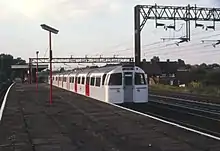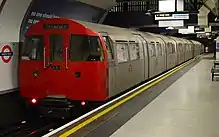London Underground 1972 Stock
The London Underground 1972 Stock is a type of rolling stock used on the London Underground. The 1972 Stock was ordered to make up the shortfall in trains on the Northern line's 1959 Tube Stock fleet; however it is nowadays used on the Bakerloo line. Following the withdrawal of the C Stock on the Circle, District and Hammersmith & City lines in June 2014, these trains are now the oldest trains on the London Underground and also, as of 2021, the oldest EMUs in passenger service in Britain, being 49 years old.
| London Underground 1972 Stock | |
|---|---|
 A 1972 Stock at Stonebridge Park in 2012 | |
 The interior of a refurbished 1972 Stock car | |
| In service | 26 June 1972 – present |
| Manufacturer | Metro-Cammell[1] |
| Built at | Washwood Heath, England[1] |
| Replaced | 1938 Stock 1959 Stock |
| Constructed | 1972–1974[1] |
| Refurbished | Tickford (at Rosyth Dockyard) 1991–1995[1] Acton Works, 2016–2018[2] |
| Formation | 7 cars per train |
| Capacity | 851 per trainset |
| Line(s) served | Bakerloo line (current) Jubilee line and Northern line (historical) |
| Specifications | |
| Train length | 113.552 m (372 ft 6.6 in) |
| Car length | DM 16.091 m (52 ft 9.5 in) T/UNDM 15.977 m (52 ft 5.0 in) |
| Width | 2.641 m (8 ft 8.0 in) |
| Height | 2.875 m (9 ft 5.2 in) |
| Traction system | Pneumatic driven camshaft (Associated Electrical Industries)[1] |
| Traction motors | LT115 DC motor (Brush Traction)[1] |
| Seating | DM/UNDM 40 per trainset T 36 per trainset 264 per trainset |
| Stock type | Deep-level tube |
| Notes | |
Construction



A total of 252 cars were built by Metro-Cammell, Washwood Heath.[1]
In the early 1970s, the 1938 Tube stock on the Bakerloo and Northern line was life-expired and due for replacement. Tentative designs for a new Northern line fleet were abandoned when the go-ahead was given for the Piccadilly line to be extended to Heathrow Airport. That required a totally new fleet of trains to replace the 1959 stock then in use. The plan was made to transfer the 1959 trains to the Northern, to allow the worst of the 1938 stock there to be scrapped, but there were only 76 1959 Tube stock trains, and the Northern line needed more than that to operate. Originally, it was planned to refurbish some 30 1938 trains, but this was scrapped in favour of 30 new trains of the 1972 Mark 1 Tube stock.
The 1972 Tube stock was ordered in a hurry, so there was no time to create a new design; the trains were based on the 1967 Tube stock on the Victoria line. Although almost identical looking, the 1972 trains had a guard and door controls in the rear car, and were not compatible with 1967 Tube stock (though in later years some 1972 cars were adapted to run with the 1967 trains on the Victoria line).
A further 33 trains of 1972 Tube stock were ordered to provide service on the Northern line. The 1972 Mark 2 stock had slightly different interiors, such as dark blue seating moquette (unlike the red and grey on the earlier 1972/1967 trains). Externally the biggest difference was that the doors were painted red, with a London Transport roundel on the side of the carriages, rather than the Johnston lettering. Unlike the 1967 or 1972 Mark 1 trains, the train number was displayed on an LED on the drivers desk, in the old trains the number box was implemented into the drivers door. The 1972 Mark 2 trains first operated on the Northern line alongside the 1972 Mark 1 trains. In 1977, they were transferred to the Bakerloo line and operated alongside the 1938 Stock until the opening of the Jubilee line in 1979. In 1989, several Northern Line units were painted in experimental liveries and three trains were internally refurbished (before the refurbishment work was stopped because of the decision to order a new fleet). 3227+3518 were painted with blue doors and a white body, 3204+3522 were painted with a blue/white body, and 3202+3523 were painted in what would become a corporate livery.
With the introduction of the 1983 Tube stock on the Jubilee in 1984, half of the 1972 Mark 2 trains were transferred back to the Northern line. After the introduction of a second batch of 1983 Stock on the Jubilee in 1987, all 1972 Mark 2 trains on the Jubilee and Northern lines were transferred to the Bakerloo line, where they remain in service. The earlier (Mark 1) 1972 stock on the Northern line was replaced by 1995 Tube Stock in 1999. After being withdrawn from the Northern line, a few cars of 1972 Mark 1 stock were converted to run with 1967 stock in service on the Victoria line. A further two trains were converted to be compatible with the Mark II type, and these now run on the Bakerloo line. One ex Northern line set (3229) is permanently based at the now-closed Aldwych station, for use in films. Another Mark 1 unit in a trial livery was sent to Acton Works to be used for shunting. One 3 car unit (unit 3511)[3] resides at Hainault depot. It is in an extremely poor condition and will most likely never return to service.
The 1972 trains are formed of seven-car sets, and have a total of 268 passenger seats. After withdrawal from the Northern Line, five 4 car units (units 3201, 3208, 3211, 3212 and 3230)[4] were considered to be used on the Waterloo and City Line. The objective was to supply the Central Line with extra 1992 stock. This never happened and the trains were sent to Mayer Perry or the CF Booth of Rotherham to be scrapped.
The fleet was refurbished between 1991 and 1995 by Tickford at Rosyth Dockyard.[1] From 2016-2018, the fleet was again refurbished at Acton Works to enable the trains to remain in service until their forecast replacement date of 2035.[2] The class received the Class 499/2 designation on British Rail's TOPS system to operate on the Bakerloo line north of Queens Park.[5]
Roster
← Elephant & Castle (A) Harrow & Wealdstone (D) → | ||||||||
| Formation | 32xx (DM) |
42xx (T) |
43xx (T) |
33xx (DM) |
34xx (UNDM) |
45xx (T) |
35xx (DM) | |
| Numbers | Mark I | 3264 : 3267 |
4264 : 4267 |
4364 : 4365 |
3364 : 3365 |
3464 : 3467 |
4564 : 4567 |
3564 : 3567 |
| 4367 | 3367 | |||||||
| Mark II | 3231 : : : 3248 |
4231 : : : 4248 |
4331 : : : 4348 |
3331 : : : 3348 |
3431 : 3438 |
4531 : 4538 |
3531 : 3538 | |
| 3440 : 3463 |
4540 : 4563 |
3540 : 3563 | ||||||
| 3250 : 3256 |
4250 : 4256 |
4350 : 4356 |
3350 : 3356 | |||||
| 3258 : 3263 |
4258 : 4263 |
4358 : 4363 |
3358 : 3363 | |||||
| 4366 | 3366 | |||||||
| 3299 | 4299 | 4399 | 3399 | |||||
Future replacement
The Deep tube programme (DTP) originally covered the replacement of the trains and signalling on the Bakerloo and Piccadilly lines, and had been expanded to cover rolling stock requirements arising from the planned extension of the Northern line to Battersea, the eventual replacement of Central line trains and proposed increased service frequency on the Northern and Jubilee lines. The EVO tube concept design, a lighter articulated train with walk-through cars, was introduced early in 2011.[6] In early 2014 the Bakerloo, Piccadilly, Central and Waterloo & City line rolling-stock replacement project was renamed New Tube for London (NTfL) and moved to the design and specification stage.[7][8] The proposal introduces fully automated trains and signalling to increase capacity first on the Piccadilly line in 2025, followed by the Central, Waterloo & City and Bakerloo lines by 2033. The fully automated trains may not have drivers;[9] however, the ASLEF and RMT trade unions representing drivers strongly oppose this, saying it would be unsafe.[10]
Post-withdrawal use



| Subseries | Car number(s) | Notes |
|---|---|---|
| Mark I | 3213-4213 3313-4313 |
Converted into Asset Inspection Train: see below. |
| Mark I | 3214 | Cab converted into a static tourist exhibit at the Hamleys toy store[11] |
| Mark I | 3229-4229 4329-3329 |
Retained for filming and training purposes[12] |
| Mark I | 3530 | Static exhibit at the London Transport Museum[13] |
Asset Inspection Train
Middle two cars are 67DM vehicles - 3079, 3179. Front 2 and rear two are 72 Mark 1 stock
- Front two (72 Mark 1) 3313-4313
- Rear two (72 Mark 1) 4213-3213
Unit 3079 & 3179 have recently been overhauled at Eastleigh Works. With no cab windows and new cables leading into each other. The AIT (Asset Inspection Train) will replace the Track Recording Train (1960 Stock DMs and 73 Stock T) which is currently in use.
References
- Neil, Graham. "London Underground Rolling Stock Information Sheet" (PDF). WhatDoTheyKnow. Retrieved 17 April 2016.
- "Back on the Bakerloo". On the Move. London Underground Limited/Transport for London (64): 3. July 2019.
- "1972 MkI tube stock". SQUAREWHEELS.org.uk. Retrieved 11 March 2014.
- "1972 MkI tube stock". SQUAREWHEELS.org.uk. Retrieved 11 March 2014.
- LUL stock given TOPS numbers The Railway Magazine issue 1145 September 1996 p. 57
- Connor, Piers (January 2013). "Deep tube transformation". Modern Railways. pp. 44–47.
- "New Tube for London Programme" (PDF). Board Minutes. Transport for London. 5 February 2014. Retrieved 3 April 2014.
- "New Tube for London Programme". Railway Gazette. London. 28 February 2014. Retrieved 3 April 2014.
- "TfL prepares for driverless tube". Railnews. Stevenage. 28 February 2014. Retrieved 3 April 2014.
- "Driverless Tube trains: Unions vow 'war' over plan". BBC News. 28 February 2014. Retrieved 3 April 2014.
- "New tube station for Regent Street". IanVisits. Retrieved 11 March 2014.
- "1972 MkI tube stock". SQUAREWHEELS.org.uk. Retrieved 11 March 2014.
- "London Underground 1972-tube stock driving motor car, number 3530, 1972". London Transport Museum. Retrieved 11 March 2014.
External links
| Wikimedia Commons has media related to London Underground 1972 Stock. |
